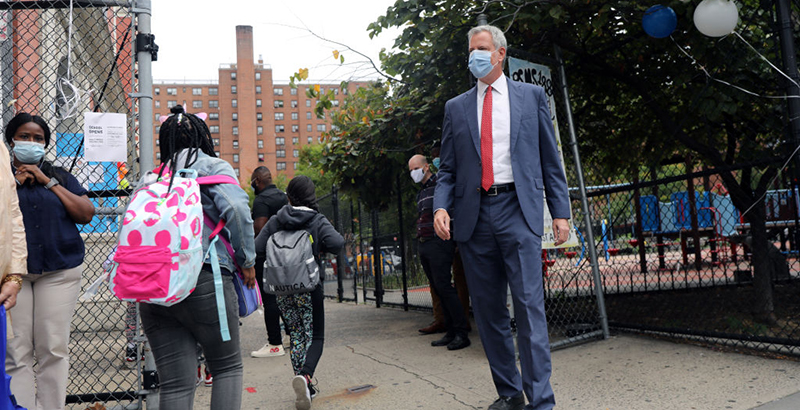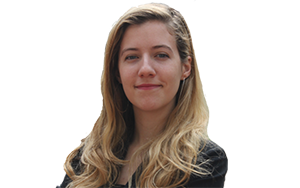Pandemic Brings Long-Sought Admissions Changes to NYC’s Highly Segregated Schools

Officials announced major changes Friday to admissions processes for selective New York City middle and high schools in the nation’s largest school district and one of its most segregated.
Mayor Bill de Blasio made the revisions — which advocates and integration supporters have long urged him to pursue — seven years into his tenure and one year before leaving office. Disruptions to testing and attendance brought on by the pandemic drove the timing of the changes, at least some of which are expected to outlast the coronavirus crisis.
New York City has a greater percentage of screened schools than any other, and selective schools citywide tend to under-enroll Black, Latino and low-income students, who comprise the majority of the system’s 1.1 million students.
“The COVID-19 crisis has exposed longstanding inequities in our City’s public schools,” de Blasio said in a statement issued Friday. “Now, as we rebuild our city, we are expanding opportunities for all public-school students and doubling down on our mission to provide a quality education for all, regardless of a child’s zip code.”
Here’s what you need to know about the changes.
1 They’ll most affect middle school admissions
About 40 percent of middle schools citywide, 196 total, are selective, and historically, they’ve been disproportionately white. The mayor’s update orders middle schools to suspend all admissions-related screens for one year, including grades, standardized test scores and attendance, in favor of a random lottery system. Those familiar with Brooklyn District 15’s admissions overhaul might recognize the idea; in 2018, that district swapped middle school screens for a lottery in order to diversify schools. Families typically submit middle school applications in the fall. This year, they have from early January through early February to do so.
2 Screening at selective high schools will basically remain the same, with a few major exceptions
Officials this year are scrapping the geographic priority policy, which has in the past given students living near selective schools first dibs on spots. The change extends to District 2, the oft-cited poster child of schools skewed in the direction of the white and wealthy. That district, which includes the Upper East Side and West Village, has nearly four times more white students than the citywide average. Students citywide are supposed to have access to any NYC high school, according to a 2004 policy issued by former Mayor Michael Bloomberg, but that change doesn’t apply to certain districts and schools that are among the most sought-after.
De Blasio’s announcement won’t touch the entrance exam for the city’s eight specialized high schools — something he can’t do without state approval. In 2019, he tried to broach that subject with the legislature, but state lawmakers refused to eliminate the single, high-stakes test that governs admission to top schools like Stuyesant and Bronx High School of Science. Some have speculated that Democratic lawmakers, who recently secured a supermajority in the state Senate, might be willing to reconsider abolishing the test, which yields admissions offers to a very small number of Black and Hispanic students each year. In the meantime, eighth- and ninth-graders hoping to enroll in those schools next year will take the Specialized High Schools Admissions Test starting in late January 2021, albeit in middle schools around the city, not just at a few campuses.
Performing arts high schools will hold virtual auditions this year; otherwise, admissions there will remain unchanged. The traditional and highly competitive audition process has also produced segregated high school enrollments, including at the famed LaGuardia High School of Music and Art and the Performing Arts, where 63 percent of students are white and Asian.
3 The city is taking steps to encourage individual districts to integrate
The mayor announced Friday that he would add five more grants for districts to craft their own diversity plans, in the vein of District 15’s efforts. That will mean 13 districts are now working on their own strategies, the mayor’s office said. They added that, over the next four years, officials intend to expand diversity planning to include all 32 community school districts.
4 Gifted and Talented screens are here to stay
Among the assessments that will remain: the controversial standardized test given to very young children for admission to elementary school Gifted and Talented programs, which is administered by a proctor one-to-one. Eliminating it was one of the recommendations of a task force appointed by the mayor in 2019, and it remains to be seen what the evaluation will look like during the pandemic. The city’s Gifted and Talented programs are overwhelmingly white and Asian.
5 The changes are a result of COVID
The mayor, who has at least nominally centered equity since his campaign days, has always had the ability to change admissions policies. In recent years, pressure has mounted for him to implement relevant revisions: In November, Teens Take Charge filed a federal complaint over high school screens contributing to segregation, and in December, District 2 principals called upon the city to eliminate the policy giving local students privileged access to their schools. But it wasn’t until the coronavirus made gathering the metrics often used in screening impractical — including grades and attendance — that de Blasio moved on the issue. After schools shuttered in March, students in younger grades changed from letter grades to pass-fail, administrators stopped using attendance records to assess student achievement, and state tests were canceled.
6 Whether they stick will probably depend on next year’s newly elected mayor
De Blasio said Friday morning that “the status quo in NYC schools cannot continue.” But only a year of his tenure remains, so decisions about whether these policy changes should endure will fall into the hands of whoever assumes office in 2022. None of the sizable group of mayoral contenders, including City Comptroller Scott Stringer, Brooklyn borough President Eric Adams and former sanitation commissioner Kathryn Garcia, have said much so far about school integration.
Sophie Mode, the communications director of Teens Take Charge, the student advocacy group that’s pushed for school integration, said Friday she’s already looking well beyond de Blasio to the forthcoming election.
“I think this is a really important time for candidates to prove they’re committed to an agenda that prioritizes our public schools,” she told The 74, adding of the recent changes, “This is definitely progress. But it’s nowhere near enough.”
Get stories like these delivered straight to your inbox. Sign up for The 74 Newsletter

;)

